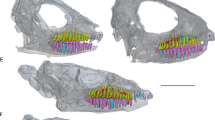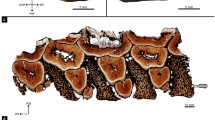Abstract
Ichthyosaurs, an extinct group of Mesozoic marine diapsids, show a relatively small range of tooth crown morphologies. With few exceptions, members of the group bear a large number of conical teeth and show only minor heterodonty within a jaw. This uniformity in gross morphology masks a high degree of variation in both the quantity and arrangement of the mineralized tooth tissues. Here, we describe tooth tissue structure and distribution in derived ichthyosaurs. We synthesize these new observations with the historical literature, to map changes in the quantity and arrangement of tooth tissues. These changes affected tooth attachment, tooth replacement, plicidentine morphology, and the amount and distribution of cellular cementum. The amount of variation detected in features relating to ichthyosaurian dentition is not surprising given the geological longevity and morphological disparity of the group, but does emphasize the importance of extensive taxon sampling in studies of tooth histology and evolution. This study is important in that it incorporates morphological and histological information in a phylogenetic and developmental context, something that is rarely done for marine reptile dentitions.
Kurzfassung
Die Ichthyosaurier, eine ausgestorbene Gruppe von mesozoischen marinen Diapsiden, zeigen nur geringe morphologische Unterschiede der Zahnkronen. Die Mitglieder der Gruppe tragen, mit wenigen Ausnahmen, eine große Anzahl von konischen Zähnen, und zeigen nur geringfügige Heterodontie innerhalb eines Kiefers. Diese Einheitlichkeit in der Gesamtmorphologie verbirgt ein großes Ausmaß an Variation, sowohl was die Anzahl als auch die Anordnung der mineralisierten Zahngewebe betrifft. In der vorliegenden Arbeit beschreiben wir die Struktur und Verteilung des Zahngewebes bei Ichthyosauriern. Wir vergleichen diese neuen Beobachtungen mit solchen aus der Literatur, um Veränderungen der Zahngewebe bei Ichthyosauriern darzustellen. Diese Veränderungen betrafen Zahnbefestigung, Zahnersatz, Plicidentin-Morphologie und die Menge und Verteilung von zellulärem Zement. Der Grad an Variabilität, der bei den Merkmalen des Ichthyosauriergebisses festgestellt wurde, ist in Anbetracht der geologische Langlebigkeit und der morphologischen Unterschiede der Gruppe nicht überraschend, unterstreicht aber die Bedeutung der umfangreichen Probenahme an Taxa bei Untersuchungen der Zahnhistologie und -entwicklung. Diese Studie ist im Hinblick darauf wichtig, dass sie morphologische und histologische Informationen in einen phylogenetischen Zusammenhang und einen Entwicklungszusammenhang setzt, was sonst nur selten bei Gebissen von Meeresreptilien getan wird.




Similar content being viewed by others
Abbreviations
- AM:
-
Australian Museum
- ROM:
-
Royal Ontario Museum
- UALVP:
-
University of Alberta Vertebrate Paleontology
References
Andrews, C.W. 1910. A descriptive catalogue of the marine reptiles of the Oxford Clay. London: British Museum of Natural History.
Bardet, N. 1990. Dental cross-sections in Cretaceous Ichthyopterygia: Systematic implications. Geobios 23(2): 169–172.
Bauer, F. 1898. Die Ichthyosaurier des oberen weissen Jura. Palaeontographica 44: 283–328.
Besmer, A. 1947. Die Triasfauna der Tessiner Kalkalpen XVI. Beiträge zur Kenntnis des Ichthyosauriergebisses. Schweizerische Palaeontologische Abhandlungen 65: 1–21.
Bosshardt, D.D. 2005. Are cementoblasts a subpopulation of osteoblasts or a unique phenotype? Journal of Dental Research 84(5): 390–406.
Caldwell, M.W. 2007. Ontogeny, anatomy and attachment of the dentition in mosasaurs (Mosasauridae: Squamata). Zoological Journal of the Linnean Society 149: 687–700.
Caldwell, M.W., L.A. Budney, and D.O. Lamoureux. 2003. Histology of tooth attachment tissues in the Late Cretaceous mosasaurid Platecarpus. Journal of Vertebrate Paleontology 23(3): 622–630.
Camp, C.L. 1980. Large ichthyosaurs from the Upper Triassic of Nevada. Palaeontographica Abt. A 170(4–6): 139–200.
Davit-Béal, T. 2009. Loss of teeth and enamel in tetrapods: fossil record, genetic data and morphological adaptations. Journal of Anatomy 214: 477–501.
de Buffrénil, V., and J.-M. Mazin. 1990. Bone histology of the ichthyosaurs: comparative data and functional interpretation. Paleobiology 16(4): 435–447.
de Ricqlès, A., and J.R. Bolt. 1983. Jaw growth and tooth replacement in Captorhinus aguti (Reptilia: Captorhinomorpha): A morphological and histological analysis. Journal of Vertebrate Paleontology 3(1): 7–24.
Delgado, S., T. Davit-Béal, F. Allizard, and J.-Y. Sire. 2005. Tooth development in a scincid lizard, Chalcides viridanus (Squamata), with particular attention to enamel formation. Cell and Tissue Research 319: 71–89.
Diekwisch, T.G.H. 2001. Developmental biology of cementum. International Journal of Developmental Biology 45: 695–706.
Edmund, A.G. 1960. Tooth replacement phenomena in the lower vertebrates. Life Sciences Contributions, Royal Ontario Museum 52: 1–190.
Erickson, G.M. 1996a. Daily deposition of dentine in juvenile Alligator and assessment of tooth replacement rates using incremental line counts. Journal of Morphology 228: 189–194.
Erickson, G.M. 1996b. Incremental lines of von Ebner in dinosaurs and the assessment of tooth replacement rates using growth line counts. Proceedings of the National Academy of Sciences USA 93: 14623–14627.
Fraas, E. 1891. Ichthyosaurier der süddeutschen Trias- und Jura-Ablagerungen. Tübingen: H. Laupp.
Kear, B.P. 2005. Cranial morphology of Platypterygius longmani Wade, 1990 (Reptilia: Ichthyosauria) from the Lower Cretaceous of Australia. Zoological Journal of the Linnean Society 145: 583–622.
Kieser, J.A., C. Klapsidis, L. Law, and M. Marion. 1993. Heterodonty and patterns of tooth replacement in Crocodylus niloticus. Journal of Morphology 218: 195–201.
Kiprijanoff, W. 1881. Studien über die fossilen Reptilien Russlands. Theil 1. Gattung Ichthyosaurus König aus dem Sewerischen Sandstein oder Osteolith der Kreide-Gruppe. Mémoires de l’Académie Impériale des Sciences de Saint-Pétersbourg 28: 1–103.
Kozawa, Y., H. Chisaka, Y. Iwasa, R. Yokota, K. Suzuki, and H. Yamamoto. 2005. Origin and evolution of cementum as tooth attachment complex. Journal of Oral Biosciences 47(1): 25–32.
Luan, X., C. Walker, S. Dangaria, Y. Ito, R. Druzinsky, K. Jarosius, H. Lesot, and O. Rieppel. 2009. The mosasaur tooth attachment apparatus as paradigm for the evolution of the gnathostome periodontium. Evolution and Development 11(3): 247–259.
Maisch, M.W., and A.T. Matzke. 2000. The Ichthyosauria. Stuttgarter Beiträge zur Naturkunde Serie B (Geologie und Paläontologie) 298: 1–159.
Maisch, M.W., and A.T. Matzke. 2002. Observations on Triassic ichthyosaurs. Part IX. The first associated skeletal remains of Pessopteryx n.g. (Ichthyosauria, Lower Triassic) and their bearing on the systematic position of the Omphalosauria. Neues Jahrbuch für Geologie und Paläontologie Abhandlungen 226(1): 59–94.
Massare, J.A. 1987. Tooth morphology and prey preference of Mesozoic marine reptiles. Journal of Vertebrate Paleontology 7(2): 121–137.
Maxwell, E.E. 2010. Generic reassignment of an ichthyosaur from the Queen Elizabeth Islands, Northwest Territories, Canada. Journal of Vertebrate Paleontology 30(2): 403–415.
Maxwell, E.E., and M.W. Caldwell. 2006. A new genus of ichthyosaur from the Lower Cretaceous of Western Canada. Palaeontology 49: 1043–1052.
Maxwell, E.E., M.W. Caldwell, and D.O. Lamoureux. 2011. Tooth histology in the Cretaceous ichthyosaur Platypterygius australis, and its significance for the conservation and divergence of mineralized tooth tissues in amniotes. Journal of Morphology 272(2): 129–135.
Mazin, J.-M. 1981. Grippia longirostris Wiman, 1929, un Ichthyopterygia primitif du Trias inférieur du Spitsberg. Bulletin du Muséum National d’Histoire Naturelle 4: 317–340.
Mazin, J.-M. 1983. L’implantation dentaire chez les Ichthyopterygia (Reptilia). Neues Jahrbuch für Geologie und Paläontologie. Monatschefte 1983(7): 406–418.
Mazin, J.-M. 1988. Le crâne d’Ichthyosaurus tenuirostris Conybeare, 1822 (Toarcien, La Caîne, Normandie, France). Bulletin de la Société Linnéenne de Normandie 112–113: 121–132.
McGowan, C., and R. Motani. 2003. Ichthyopterygia. München: Verlag Dr. Friedrich Pfeil.
McIntosh, J.E., X. Anderton, L. Flores-de-Jacoby, D.S. Carlson, C.F. Shuler, and T.G.H. Diekwisch. 2002. Caiman periodontium as an intermediate between basal vertebrate ankylosis-type attachment and mammalian “true” periodontium. Microscopy Research and Technique 59: 449–459.
Merriam, J.C. 1908. Triassic Ichthyosauria with special reference to the American forms. Memoirs of the University of California 1: 1–196.
Motani, R. 1996. Redescription of the dental features of an Early Triassic ichthyosaur, Utatsusaurus hataii. Journal of Vertebrate Paleontology 16(3): 396–402.
Motani, R. 1997a. Temporal and spatial distribution of tooth implantation in ichthyosaurs. In Ancient marine reptiles, ed. J.M. Callaway, and E.L. Nicholls, 81–103. London: Academic.
Motani, R. 1997b. Redescription of the dentition of Grippia longirostris (Ichthyosauria) with a comparison with Utatsusaurus hataii. Journal of Vertebrate Paleontology 17(1): 39–44.
Motani, R. 1999. Phylogeny of the Ichthyopterygia. Journal of Vertebrate Paleontology 19: 472–495.
Nanci, A. 2008. Ten Cate’s oral histology: Development, structure, and function. St. Louis: Mosby Elsevier.
Nicholls, E.L., and M. Manabe. 2001. A new genus of ichthyosaur from the Late Triassic Pardonet Formation of British Columbia: Bridging the Triassic-Jurassic gap. Canadian Journal of Earth Sciences 38: 983–1002.
Ogg, J.G., G. Ogg, and F.M. Gradenstein. 2008. The concise geologic time scale. Cambridge: Cambridge University Press.
Owen, R. 1840–1845. Odontography; or a treatise on the comparative anatomy of the teeth; their physiological relations, mode of development, and microscopic structure in the vertebrate animals. London: Bailliere.
Owen, R. 1851. Monograph on the fossil Reptilia of the Cretaceous formations. London: Palaeontological Society.
Peyer, B. 1968. Comparative odontology. Chicago: University of Chicago Press.
Rieppel, O. 2001. Tooth implantation and replacement in Sauropterygia. Paläontologische Zeitschrift 75(2): 207–217.
Rieppel, O., and M. Kearney. 2005. Tooth replacement in the Late Cretaceous mosasaur Clidastes. Journal of Herpetology 39(4): 688–692.
Sander, P.M. 1999. The microstructure of reptilian tooth enamel: terminology, function, and phylogeny. Münchner Geowissenschaftliche Abhandlungen (A) 38: 1–102.
Sander, P.M. 2000a. Ichthyosauria: Their diversity, distribution and phylogeny. Paläontologische Zeitschrift 74(1/2): 1–35.
Sander, P.M. 2000b. Prismless enamel in amniotes: Terminology, function and evolution. In Development, function and evolution of teeth, ed. M.F. Teaford, M.M. Smith, and M.W.J. Ferguson, 92–106. Cambridge: Cambridge University Press.
Sander, P.M., and C. Faber. 2003. The Triassic marine reptile Omphalosaurus: Osteology, jaw anatomy, and evidence for ichthyosaurian affinities. Journal of Vertebrate Paleontology 23(4): 799–816.
Scanlon, J.D., and M.S.Y. Lee. 2002. Varanoid-like dentition in primitive snakes (Madtsoiidae). Journal of Herpetology 36(1): 100–106.
Schultze, H.-P. 1969. Die Faltenzähne der Rhipidistiiden Crossopterygier, der Tetrapoden und der Actinopterygier-Gattung Lepisosteus; nebst einer Beschreibung der Zahnstruktur von Onychodus (Struniiformer Crossopterygier). Palaeontographica Italica, New Series 35 65: 63–137.
Sereno, P.C., J.A. Wilson, L.M. Witmer, J.A. Whitlock, A. Maga, O. Ide, and T.A. Rowe. 2007. Structural extremes in a Cretaceous dinosaur. PLoS ONE 2(11): e1230.
Shimada, K., I. Sato, and H. Moriyama. 1992. Morphology of the tooth of the America alligator (Alligator mississippiensis): The fine structure and elemental analysis of the cementum. Journal of Morphology 211: 319–329.
Sire, J.-Y., P.C.J. Donoghue, and M.K. Vickaryous. 2009. Origin and evolution of the integumentary skeleton in non-tetrapod vertebrates. Journal of Anatomy 214: 409–440.
Warren, A., and S. Turner. 2006. Tooth histology patterns in early tetrapods and the presence of ‘dark dentine’. Transactions of the Royal Society of Edinburgh: Earth Sciences 96: 113–130.
Westergaard, B., and M.W.J. Ferguson. 1987. Development of the dentition in Alligator mississippiensis. Later development in the lower jaws of embryos, hatchlings and young juveniles. Journal of Zoology, London 212: 191–222.
Westergaard, B., and M.W.J. Ferguson. 1990. Development of the dentition in Alligator mississippiensis: Upper jaw dental and craniofacial development in embryos, hatchlings, and young juveniles, with a comparison to lower jaw development. American Journal of Anatomy 187: 393–421.
Acknowledgments
We would like to thank D. Evans (Royal Ontario Museum), R. Jones (Australian Museum, Sydney), and J. McNamara (South Australia Museum, Adelaide) for access to specimens. Thanks are due to B. Barr for discussions and comments during manuscript preparation, P. Druckenmiller and M. Zammit provided helpful reviews. K. Wolkenstein and R. Böttcher assisted with abstract translation. Financial support was provided by an I.W. Killam Memorial Postdoctoral Fellowship to E.E.M., and a Natural Sciences and Engineering Research Council (NSERC) Discovery Grant (#238458-01) and University of Alberta Chair’s Research Allowance to M.W.C.
Author information
Authors and Affiliations
Corresponding author
Rights and permissions
About this article
Cite this article
Maxwell, E.E., Caldwell, M.W. & Lamoureux, D.O. Tooth histology, attachment, and replacement in the Ichthyopterygia reviewed in an evolutionary context. Paläontol Z 86, 1–14 (2012). https://doi.org/10.1007/s12542-011-0115-z
Received:
Accepted:
Published:
Issue Date:
DOI: https://doi.org/10.1007/s12542-011-0115-z




